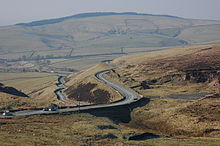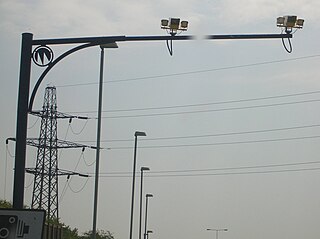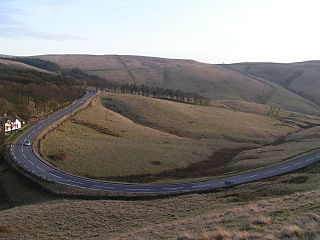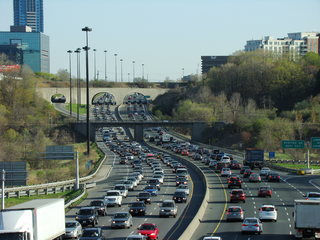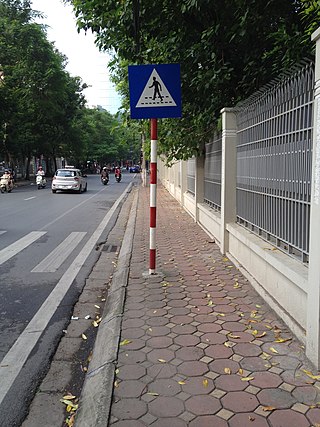Road safety initiatives
A 2016 report indicates that between 2007 and 2011, there were 44 serious or fatal crashes on the 7.5 mile stretch. Between 2002 and 2006, there were 35. The report states that the safety issue is caused by "severe bends, steep falls from the carriageway and edged by dry-stone walls for almost the entirety of the road". [3]
As a result, the speed limit on the section between Macclesfield and the Cat and Fiddle Inn was reduced to 50 mph (80 km/h) from the national 60 mph (97 km/h) limit. The road is regularly patrolled by unmarked police cars and motorcycles and a mobile speed camera van is used most weekends during the summer. A police aircraft is often used in conjunction with these to enforce the speed limit.
The road was named as the UK's most dangerous in a 2008 survey. [4] The single-carriageway route was the location of 21 fatal and serious crashes and was rated in the EuroRAP report as Black, the highest risk rating. [5] This was in spite of a number of countermeasures installed by the road authority, including motorcycle-friendly barriers. The Foundation attributed this high number of accidents to road user behaviour; indeed, when motorcycle-related collisions are removed from the results the road became one of the safest in the country. [5]
Cheshire County Council also pointed the finger at motorcyclists' behaviour: [6]
"The fact is that it’s an attractive road to motorcyclists – they see it as a challenge to ride with its hairpin bends, limited views, downhill descent and uphill ascent. The thing that angers us most is not the fact that it’s dangerous, but that there are a group of people on that road who knowingly push the boundaries. We have tried to get the message across, that it is the emergency services that have to pick these people up off the road and have the duty of telling their families that they have killed themselves."
Having already spent £500,000 on a number of safety measures (including reducing the speed limit, installing high-friction surfacing, barriers and signs, widening the carriageway and using mobile speed cameras), [7] in January 2009 it was revealed that Cheshire Council, on behalf of Cheshire Safer Roads Partnership and Derbyshire Partnership for Road Safety, intended to spend a further £1.2 million on installing average-speed cameras along this road. [8] Installation of these cameras began in February 2010. [9] However, the initial operation of the cameras did not go smoothly, because along the full route of the cameras' operation there are a number of shortcuts which have the full national speed (60 mph) and decrease the overall distance of the route. These two factors, when combined, can give inaccurate readings from the speed cameras. [10] The average-speed camera scheme is a joint initiative between the Cheshire Safer Roads Partnership (including Cheshire East Council), Lee Murphy, Cheshire Safer Roads Partnership manager, said: "Major resources have been committed to the Cat and Fiddle road since 2000, including reducing the speed limit, high-friction surfacing, high-visibility warning signs, red warnings painted on the road, motorcycle-friendly safety barriers, enforcement signs, carriageway widening, mobile safety cameras and police operations. Even without police costs, we estimate that more than £500,000 has been spent on the road in Cheshire alone. Despite all this work, casualties remain high."
Of the 264 casualties on the road since 2001, approximately 70% of those killed or seriously injured were motorcyclists, the main causes being poor cornering/manoeuvring, exceeding the speed limit and failing to judge another vehicle’s speed/distance. "The information and statistics show that it is riding behaviour not the road condition that causes the majority of collisions. We don’t have a problem with other road users not seeing bikes, because the majority of collisions are single vehicles," added Murphy. [11]
The Cat and Fiddle again topped the list in the 2010 report, which claimed that fatalities on the road rose from 15 in the three years to 2005 to 34 between 2006 and 2008. [12] However, following the introduction of further safety measures including improved road barriers, a 50mph speed limit and the installation of average speed cameras, the road dropped out of the Foundation's top ten list in 2015. [13]
